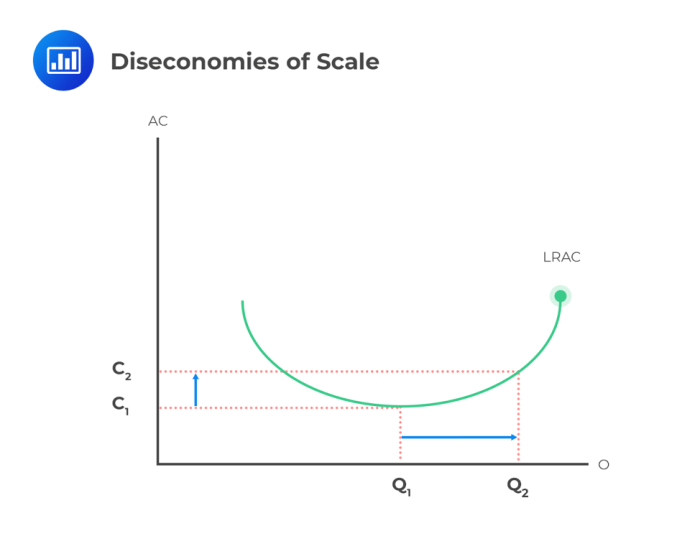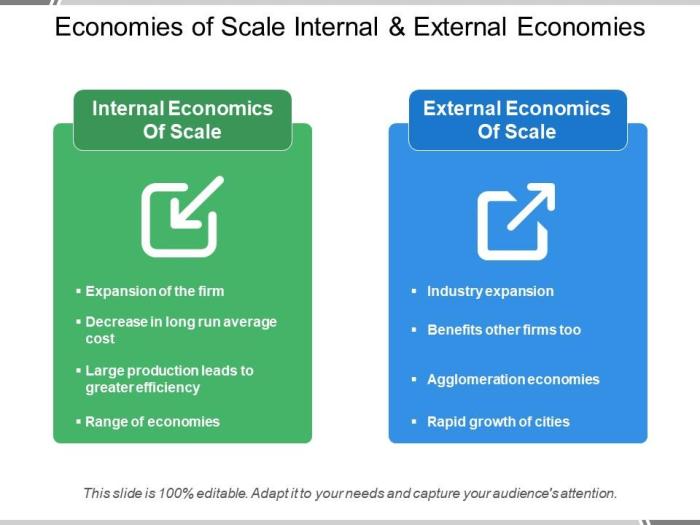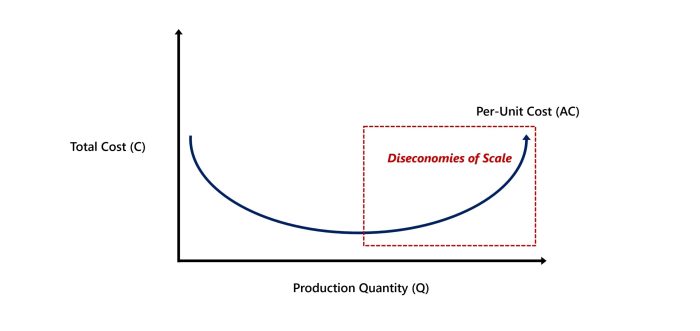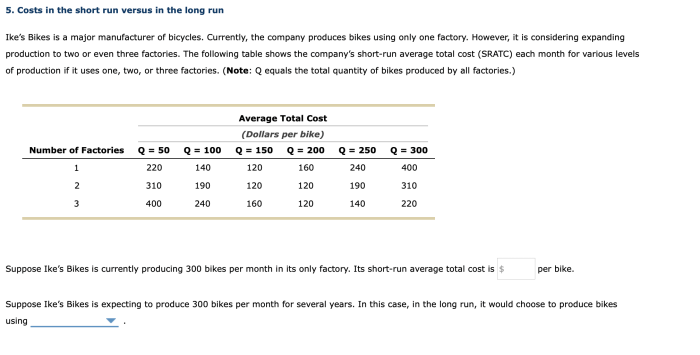The transition from economies of scale to diseconomies of scale marks a critical juncture for businesses, where the pursuit of efficiency and growth encounters a paradoxical shift. As organizations expand, the initial advantages of scale give way to challenges that can undermine profitability and sustainability.
This exploration delves into the complexities of this transition, examining its triggers, consequences, and strategies for mitigation, offering valuable insights for navigating the complexities of scale.
Economies of scale, characterized by reduced per-unit costs with increased production, often drive initial business growth. However, as organizations surpass optimal size, diseconomies of scale emerge, leading to inefficiencies, rising costs, and diminishing returns. Understanding this transition is crucial for businesses to make informed decisions and adapt their strategies accordingly.
Understanding the Transition: The Transition From Economies Of Scale To Diseconomies Of Scale

The transition from economies of scale to diseconomies of scale occurs when the benefits of increasing production size and efficiency begin to diminish and are outweighed by the negative consequences of increased scale.
Economies of scale refer to the cost advantages that businesses enjoy when they increase their production output. These advantages can include lower production costs per unit, increased efficiency, and improved profitability.
However, as businesses continue to grow, they may reach a point where the benefits of economies of scale are no longer sufficient to offset the negative effects of diseconomies of scale.
Factors Triggering the Transition
- Increased Complexity:As organizations expand, their operations become more complex, leading to coordination challenges, communication breakdowns, and increased bureaucracy.
- Diminishing Marginal Returns:At a certain point, the additional output gained from increasing production may not be proportional to the increased costs incurred.
- Capacity Constraints:Physical limitations, such as space, equipment, and labor availability, can restrict further expansion and result in inefficiencies.
- Bureaucracy and Red Tape:Excessive administrative procedures and hierarchical structures can slow down decision-making and hamper innovation.
Consequences of Diseconomies of Scale
Diseconomies of scale can have significant negative impacts on businesses, including:
Increased Production Costs
- Inefficient Operations:Larger organizations may experience coordination issues, resulting in wasted resources and higher production costs.
- Duplication of Functions:As departments grow, there may be overlaps in responsibilities, leading to inefficiencies and increased costs.
Reduced Efficiency
- Slow Decision-Making:Hierarchical structures and complex communication channels can delay decision-making, reducing responsiveness and agility.
- Bureaucratic Obstacles:Excessive red tape and administrative procedures can hinder innovation and impede progress.
Diminished Profitability
- Increased Fixed Costs:Larger organizations often have higher fixed costs, such as overhead expenses, which can erode profitability.
- Lower Marginal Returns:As production increases, the marginal revenue generated may not be sufficient to cover the increased costs, leading to declining profitability.
Identifying Diseconomies of Scale

Businesses can identify signs of diseconomies of scale through:
Financial Analysis
- Cost-Volume-Profit Analysis:Comparing production costs to revenue at different output levels can reveal diminishing returns.
- Unit Cost Analysis:Tracking the cost per unit produced can indicate whether costs are increasing disproportionately to output.
Operational Assessment
- Communication Bottlenecks:Identifying communication delays and breakdowns can point to excessive bureaucracy.
- Coordination Challenges:Assessing the efficiency of coordination between departments can uncover inefficiencies and duplication.
- Capacity Constraints:Analyzing production capacity and utilization rates can reveal whether physical limitations are hindering growth.
Case Studies
- General Motors:In the 1970s, GM experienced diseconomies of scale due to excessive bureaucracy, poor communication, and coordination issues.
- Kodak:The company’s failure to adapt to digital photography led to diseconomies of scale as its traditional film-based business declined.
Strategies for Mitigating Diseconomies of Scale

Businesses can mitigate the effects of diseconomies of scale through various strategies, including:
Outsourcing and Partnerships
- Outsourcing Non-Core Functions:Partnering with specialized providers can reduce costs and improve efficiency.
- Strategic Alliances:Collaborating with other organizations can share resources and reduce duplication.
Decentralization and Empowerment, The transition from economies of scale to diseconomies of scale
- Empowering Employees:Giving employees decision-making authority can speed up decision-making and reduce bureaucracy.
- Decentralizing Operations:Dividing the organization into smaller, autonomous units can improve flexibility and reduce coordination challenges.
Process Optimization and Technology
- Automating Processes:Using technology to automate repetitive tasks can reduce costs and improve efficiency.
- Lean Manufacturing:Implementing lean principles can eliminate waste and improve production flow.
Impact on Business Decisions

The transition from economies of scale to diseconomies of scale has significant implications for business decisions:
Production Strategies
- Diversification:Businesses may diversify their product offerings to reduce the impact of diminishing returns.
- Vertical Integration:Acquiring suppliers or distributors can reduce costs and improve control over production.
Marketing Plans
- Target Niche Markets:Focusing on specific customer segments can reduce competition and increase profitability.
- Product Differentiation:Creating unique products or services can reduce price sensitivity and maintain profitability.
Resource Allocation
- Invest in Innovation:Allocating resources to research and development can lead to new products or processes that mitigate diseconomies of scale.
- Training and Development:Investing in employee training can improve productivity and reduce coordination challenges.
Questions Often Asked
What are the primary factors that trigger the transition from economies of scale to diseconomies of scale?
Factors such as increasing complexity, communication challenges, coordination difficulties, and diminishing employee motivation can contribute to this transition.
How do diseconomies of scale impact production costs?
Diseconomies of scale can lead to higher per-unit production costs due to inefficiencies, reduced productivity, and increased overhead expenses.
What are some common signs of diseconomies of scale within an organization?
Signs include declining profit margins, increasing production costs, and challenges in maintaining quality standards.
